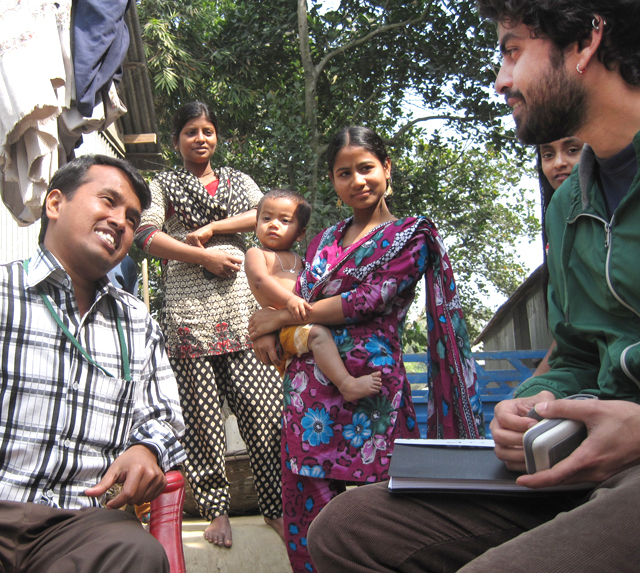The HSU alum picks up the tale:
“Our work with solar lighting requires much of the research to be done in the dark hours. As we near a rural village, a group of people off in the distance begins to approach our vehicle. All of a sudden, several solar lamps turn on and their glow streaks across the night sky. Then the voices begin: beautiful, energetic, full of life and pure joy. The villagers all gather to greet us with praise and gratitude, singing and dancing with the solar lamps in hand that we had distributed the week prior.”

Jennifer Tracy is one of eight alumni from the Schatz Energy Research Center who are burnishing Humboldt State’s reputation abroad with their work on long-term clean-energy projects that now span both Africa and Asia. The SERC also has links with Canada, Central America, Europe, Mexico and the Middle East.
The newest foray is India. Schatz Lab graduates are helping to lay the foundations to expand the Lighting Africa program begun in 2008 to the subcontinent. The aim is to accelerate India’s development of a solar energy market for hundreds of millions of Indians who have little or no electric power.
Today Jennifer is a consultant to the International Finance Corporation, an arm of the World Bank Group, Washington, D.C., which funds Lighting Asia and Lighting Africa. She focuses on research related to the social and economic development implications of modern off-grid lighting for both programs. She recently returned from a visit to India, where she was joined by Schatz Lab Director Arne Jacobson to consult with Indian officials about the solar lighting initiative.
The Schatz ‘eight’ works as a team on Lighting Africa and Lighting Asia, interweaving their knowledge and experience from one continent to the other.
One of Jennifer’s fellow alumni is Chris Carlsen (’11 Environmental Resources Engineering), who worked at Schatz Lab throughout his two years at HSU and is now a consultant to the World Bank based in Dakar, Senegal. He provides technical support for Lighting Africa.
Chris echoes Jennifer. Everyday technologies can have a profound impact in the developing world, he says, “if they are truly appropriate and if they are implemented properly. It’s inspiring to see a family experience electric lighting in their house for the first time. We have a constantly growing body of evidence that these small, low-cost lighting products can be an effective entry point to basic access to modern energy services.”
The Schatz Lab is the leader and coordinator of a network of international laboratories that conducts rigorous testing to ensure the quality of solar off-grid lighting products sold in African and Asian markets, now including India. The products range in price from about $10 to $150. Solar-powered lights and lanterns are manufactured in various sizes, from reading lamps to multiple-room household lighting.
The Schatz Lab’s testing and quality assurance operations in India are in their first phase. They are one element of a three-year, roughly five million dollar program funded by the IFC. According to its figures, nearly 800 million Asians live much of the time in a state of near darkness, including some 400 million Indians.
Long established internationally, Schatz is a partner in both programs, which are aimed at developing private and sustainable off-grid lighting markets in the developing world. The advantages are environmental as well as economic: off-grid illumination replaces costly, dirty and dangerous kerosene lamps and expensive battery-powered flashlights.
Clean, rechargeable LED lamps have emerged in recent years as an affordable alternative to fuel-based lighting in many off-grid areas of Africa, Asia, and beyond. Schatz’s key role in quality assurance helps to catalyze markets for modern off-grid lighting. Commercial sales have soared as lighting quality has improved and prices have dropped. An added benefit is that solar devices can be used for mobile phone charging.
“India offers a tremendous potential for the solar off-grid lighting market, given the minimal market penetration,” according to an IFC market analysis.
“Lighting Asia and Lighting Africa are market transformation projects,” says Schatz Director Jacobson. “By transformation, we mean identifying barriers to market development and addressing them so that private markets can take root and thrive.”
For example, Schatz is working with a number of organizations internationally, including key agencies in the Indian government, to create an accepted set of quality and durability standards for solar-charged LED lighting systems.
Jacobson is also involved in the IFC’s consideration of whether to launch Lighting Asia program activities in Bangladesh. He visited the capital Dhaka following his recent meetings in New Delhi. Beside India and Bangladesh, the IFC has analyzed the potential off-grid, rechargeable lighting markets in five other Asian countries: Cambodia, Indonesia, Nepal, Pakistan and the Philippines.